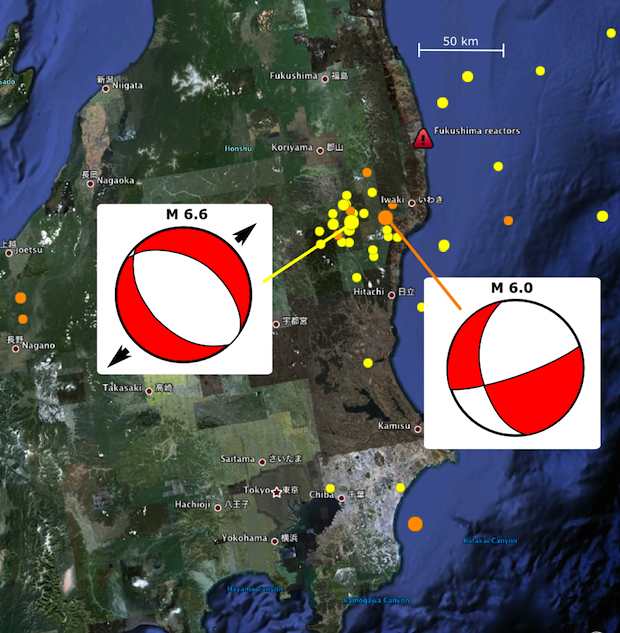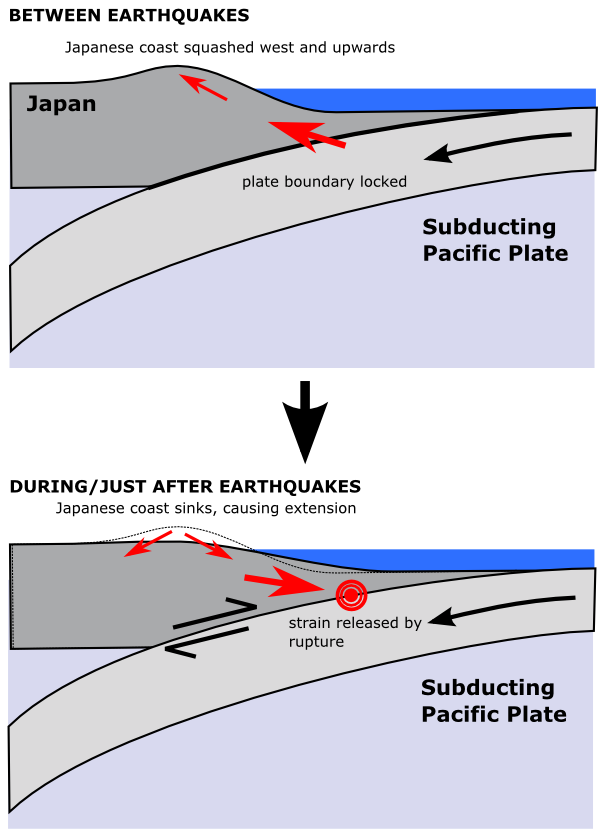![]() It’s been a month since the Tohuku earthquake and tsunami rattled then swamped northern Honshu, and Japan continues to be rattled by sizeable aftershocks. A magnitude 7.1 shock last Thursday initially set off further tsunami alerts but the rupture turned out be 50 km beneath the seafloor, too deep to pose a significant threat. Even more media attention was focussed on a magnitude 6.6 on Monday, which cut off the power at the crippled Fukushima nuclear plant for almost an hour: a serious worry given the ongoing problems with cooling the damaged reactors at this plant. A further magnitude 6 aftershock earlier today also prompted an evacuation.
It’s been a month since the Tohuku earthquake and tsunami rattled then swamped northern Honshu, and Japan continues to be rattled by sizeable aftershocks. A magnitude 7.1 shock last Thursday initially set off further tsunami alerts but the rupture turned out be 50 km beneath the seafloor, too deep to pose a significant threat. Even more media attention was focussed on a magnitude 6.6 on Monday, which cut off the power at the crippled Fukushima nuclear plant for almost an hour: a serious worry given the ongoing problems with cooling the damaged reactors at this plant. A further magnitude 6 aftershock earlier today also prompted an evacuation.
A magnitude 6 earthquake is not insignificant, of course, but these particular aftershocks are particularly ill-located with respect to Fukushima. As the map below shows, they are part of a cluster of quite shallow (10-20 km) tremors that is centred only about 50 km to the southwest of the reactors. As events in Christchurch taught us, when it comes to the strength of shaking, a weaker earthquake can be pretty damaging if you’re parked right next door to the rupture, and the Fukushima plant is close enough to get shaken around pretty strongly by events of this size.

Recent aftershocks close to the crippled Fukushima nuclear plant (yellow circles, last 7 days, orange circles, last 24 hours). Imagery from Google Earth.
The focal mechanisms from these events are interesting: Monday’s magnitude 6.6 appears to show northeast-southwest extension, and today’s magnitude 6 appears to be mainly due to strike-slip faulting, but also with a hint of extension. All of the aftershocks in this cluster are firmly located in the over-riding plate of the subduction zone that ruptured last month; they are too shallow, and too far to the west of the plate boundary, to have occurred on the subduction interface itself. Remember that during the main shock, the Japanese mainland moved east and down as elastic strain built up across the plate boundary since it last ruptured was released. Another way of thinking about this is that prior to the earthquake, the east coast of Japan was braced against a strong, locked, subduction thrust. Now that buttress has been removed, Japan is spreading and settling outwards. Extension, some of which will be accommodated by faulting, is a natural consequence of this.

Build-up and release of strain on the subduction zone leads to elevation/compression and subsidence/extension on the Japanese mainland. Note that these movements (of metres to tens of metres) have been extremely vertically exaggerated on this figure.
These earthquakes are therefore well within the realm of expected aftershock behaviour following a large earthquake on a nearby subduction zone. If you relied only on the media coverage, you might think there had been a ramping up of activity in the past few days, but it is more likely just that the location of these earthquakes – and their impact on the ongoing crisis at Fukushima – means that they have just been more widely noticed than tremors of a similar size offshore. From my initial assessment of aftershock activity, we should be expecting a magnitude 6-7 aftershock every 30 hours or so on average at this point, and they’ll continue to be a weekly hazard for several more months to come. Hopefully, not all of them will be so unfortunately located.



Comments (6)
Links (1)
-
Pingback: Not to scale | Highly Allochthonous